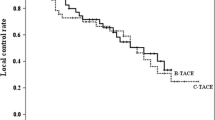Abstract
Purpose: Patients undergoing transarterial chemoembolization (TACE) for hepatocellular carcinoma (HCC) commonly have significant post-procedural abdominal pain necessitating narcotic administration. It is known that intraarterial administration of lidocaine is effective in controlling the pain during the procedure. However, optimum timing of the lidocaine administration is not precisely known. The purpose of this study was to assess the efficacy of intraarterial lidocaine administration for control of pain resulting from TACE and to evaluate the optimal timing of administration. Methods: In a prospective trial, 113 consecutive patients with HCC who underwent TACE were classified into three groups: those who received a lidocaine bolus intraarterially immediately prior to TACE (group A, n = 30), those who received lidocaine immediately after TACE (group B, n = 46), and those who did not received lidocaine (group C, n = 37). Incidence and degree of post-procedural pain was assessed using a subjective method (visual analogue scales scored from 0 to 10) and an objective method (amount of post-procedural analgesics). Results: The incidence of post-procedural pain in group A (16.7%) was significantly lower than that of group B (38.3%; p = 0.005). The mean pain score was 3.0 in group A and 4.8 and 3.1 in groups B and C, respectively. The mean dose of analgesic used after the procedure in group A (25.0 mg) was significantly lower than those in group B (52.9 mg) and group C (41.0 mg; p = 0.002). Conclusions: Pre-TACE intraarterial administration of lidocaine is much more effective than post-TACE administration in reducing the incidence and the severity of post-procedural pain. Furthermore, in order to reduce the incidence of post-procedural pain and dose of post-procedural analgesics, we recommend routine pre-TACE administration of lidocaine because post-procedural pain might developed even in patients who did not feel any pain during the TACE.
Similar content being viewed by others
Author information
Authors and Affiliations
Rights and permissions
About this article
Cite this article
Lee, S., Hahn, S. & Park, S. Intraarterial Lidocaine Administration for Relief of Pain Resulting from Transarterial Chemoembolization of Hepatocellular Carcinoma: Its Effectiveness and Optimal Timing of Administration. CVIR 24, 368–371 (2001). https://doi.org/10.1007/s00270-001-0073-z
Published:
Issue Date:
DOI: https://doi.org/10.1007/s00270-001-0073-z




